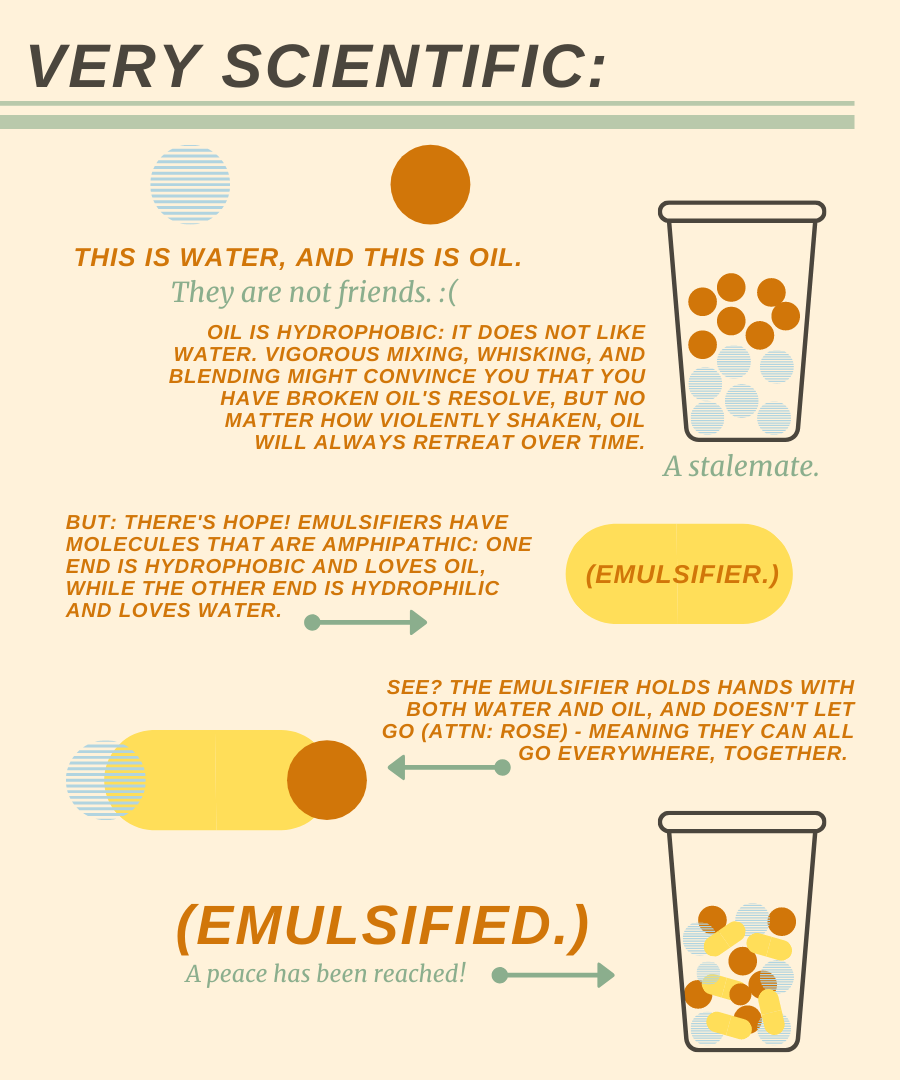Emulsifier In Food: Essential Component for Perfect Ice Cream Texture
Wiki Article
Why It Is Necessary to Integrate an Emulsifier in Food for Optimum Preference and High Quality
Emulsifiers play an important duty in food production by guaranteeing the stable blending of immiscible liquids, such as oil and water. They reduce interfacial stress, which avoids the separation of active ingredients and adds to an uniform structure. This not just enhances mouthfeel however additionally influences flavor assumption. Understanding the need of emulsifiers exposes much deeper insights into their feature and significance in cooking applications. What ramifications does this have for food development and customer choices?Understanding Emulsifiers: The Fundamentals
Emulsifiers play an essential function in food science, working as agents that assist in the mixing of two immiscible liquids, such as oil and water. These compounds have both hydrophilic (water-attracting) and hydrophobic (water-repelling) homes, which enable them to support solutions. Usual emulsifiers consist of lecithin, found in egg yolks and soybeans, and mono- and diglycerides, obtained from fats.The Scientific research Behind Emulsification
When 2 immiscible fluids are integrated, the procedure of emulsification becomes essential for attaining a secure combination. Emulsification entails spreading one fluid within an additional, generally oil in water or vice versa. This process happens with mechanical anxiety, which breaks the larger droplets into smaller sized ones, thereby enhancing the area. Nonetheless, without the presence of emulsifiers, these droplets would coalesce, leading to separation.Emulsifiers are particles with hydrophilic (water-attracting) and hydrophobic (water-repelling) homes. Their special structure enables them to reduce the interfacial tension between the 2 immiscible fluids, supporting the solution. This stabilization avoids separation and boosts the uniformity of texture and taste. The interactions at the molecular degree are necessary for maintaining the stability of the emulsion, guaranteeing that food preserve their wanted uniformity and taste. Understanding this scientific research is substantial for food scientists and suppliers in developing high-quality food.
Kinds Of Emulsifiers Utilized in Food
The kinds of emulsifiers made use of in food can be generally categorized right into artificial and natural selections. Usual food emulsifiers, such as lecithin and mono- and diglycerides, play a vital function in enhancing food security and appearance. Comprehending these distinctions is essential for appreciating exactly how emulsifiers add to the general quality of food.Synthetic vs. all-natural Emulsifiers
While both natural and synthetic emulsifiers serve the vital duty of maintaining mixes in food items, their beginnings and qualities differ significantly. All-natural emulsifiers, derived from plant or pet resources, include lecithin, casein, and specific gum tissues. They are often perceived as healthier choices, interesting consumers looking for clean-label items. In contrast, synthetic emulsifiers, such as mono- and diglycerides, are chemically engineered and might supply boosted stability and functionality in a larger variety of applications. These artificial choices can be more economical and offer constant high quality. They might stimulate apprehension among health-conscious customers. Eventually, the selection in between artificial and natural emulsifiers depends upon the preferred high qualities of the food, consisting of appearance, flavor, and shelf-life stability.Common Food Emulsifiers
Emulsifiers play a crucial role in the food sector, ensuring the stability and appearance of numerous items. Common food emulsifiers include lecithin, mono- and diglycerides, and polysorbates. Emulsifier In Food. Lecithin, originated from resources like soybeans and egg yolks, is commonly utilized in baked products and chocolates. Mono- and diglycerides, commonly acquired from veggie oils, improve the creaminess of margarine and ice lotion. Polysorbates, synthetic emulsifiers, are frequently located in salad dressings and sauces, advertising a smooth consistency. Various other emulsifiers such as xanthan periodontal and guar periodontal, both natural thickeners, likewise contribute to the desired appearance in different foodstuff. Each emulsifier kind offers specific functions, adding to the overall high quality and appeal of food things
Role in Food Security
Food security is substantially affected by the kinds of emulsifiers used, which assist avoid the separation of ingredients in different formulations. Emulsifiers such as lecithin, mono- and diglycerides, and polysorbates play necessary functions in maintaining the uniformity of items like dressings, sauces, and gelato. Lecithin, originated from soy or egg yolk, is particularly effective because of its all-natural homes, while mono- and diglycerides boost structure and shelf life. Polysorbates, on the various other hand, boost the security of oil-in-water emulsions, making them ideal for baked items. The option of emulsifier relies on the details food application and desired features, guaranteeing that items remain steady, appealing, and of premium quality throughout their intended service life.Just How Emulsifiers Improve Texture and Mouthfeel
Enhancing the sensory experience of food, emulsifiers play an important function in enhancing appearance and mouthfeel. These materials help with the consistent circulation of ingredients, enabling a smoother and creamier consistency in products such as dressings, sauces, and ice creams. By maintaining mixes of oil and water, emulsifiers stop separation, leading to a natural structure that improves the general consuming experience.
Moreover, emulsifiers can modify the viscosity of food products, adding to a desirable thickness or creaminess. This change of texture can influence just how food really feels in the mouth, influencing satisfaction and enjoyment. Furthermore, by developing a secure solution, emulsifiers aid maintain the stability of the item, making certain that the desired mouthfeel is continually supplied gradually. On the whole, the application of emulsifiers is essential for accomplishing the ideal texture and mouthfeel, eventually boosting the high quality of food.
The Duty of Emulsifiers in Taste Improvement
Taste improvement in culinary applications usually rests on the efficient use emulsifiers. These compounds facilitate the blending of water and oil, enabling the even distribution of taste substances within food products. By creating stable emulsions, emulsifiers help to envelop and launch unstable tastes, boosting the overall useful source sensory experience.Additionally, emulsifiers can enhance the assumption of preference by influencing the mouthfeel and appearance of dishes. A smoother, extra cohesive item can cause a heightened perception of tastes, making them much more pronounced and satisfying. In addition, emulsifiers can shield delicate tastes from degradation, guaranteeing that they continue to be intact throughout processing and storage space.
Emulsifiers in Popular Food Products
How do emulsifiers contribute to the structure and stability of preferred food items? Emulsifiers play a vital role in different commonly eaten products. In salad dressings, they ensure a smooth blend of oil and vinegar, avoiding splitting up and improving mouthfeel. In ice cream, emulsifiers develop a velvety appearance by stabilizing air bubbles, causing an indulgent and abundant product. Baked products, such as bread and cakes, gain from emulsifiers by improving volume and crumb structure, leading to a lighter and much more attractive texture. Additionally, mayonnaise counts on emulsifiers to maintain its thick consistency and avoid oil splitting up. Margarine and spreads additionally make use of emulsifiers to achieve a spreadable texture while maintaining stability. These instances highlight the significant effect of emulsifiers on the high quality and satisfaction of daily food, highlighting their relevance in modern food formula.The Future of Emulsifiers in Food Technology
The future of emulsifiers in food development is marked by substantial innovations in technology, leading the way for brand-new solutions. In addition, the demand for healthier emulsifier alternatives is increasing, triggering scientists to check out all-natural and plant-based options. Sustainable sourcing practices are likewise becoming essential, as consumers significantly prioritize environmental duty in their food selections.Advancements in Emulsifier Technology
As scientists remain to discover the molecular complexities of emulsifiers, substantial innovations are emerging that guarantee to change food technology. Current developments concentrate on developing a lot more functional and efficient emulsifiers that enhance appearance, security, and flavor in various food. Technologies in biopolymer-based emulsifiers are obtaining grip, providing boosted sustainability and performance over conventional alternatives. In addition, developments in nanotechnology are making it possible for the design of emulsifiers at the molecular level, which can lead to finer emulsions and improved sensory experiences. These technical advancements are not only enhancing item quality yet likewise broadening the range of applications for emulsifiers in the food market. As these developments unravel, they are anticipated to redefine culinary opportunities and consumer preferences in the future.Much Healthier Emulsifier Alternatives
While conventional emulsifiers have played a vital role in food production, there is an expanding need for much healthier options that align with consumer preferences for all-natural components and tidy tags. Technologies in plant-based emulsifiers, such as those derived from soy, flaxseed, and sunflower, have actually obtained popularity because of their perceived health and wellness advantages. These choices often contain less additives and supply performance comparable to artificial emulsifiers. In addition, ingredients like aquafaba, the liquid from prepared chickpeas, have emerged as versatile emulsifying representatives, appealing to vegan and health-conscious consumers. Emulsifier In Food. The shift towards these much healthier emulsifiers not just improves the appeal of food products but also sustains the pattern of openness in component sourcing, inevitably cultivating customer count on and satisfaction
Sustainable Sourcing Practices
Lasting sourcing techniques are ending up being progressively important in the growth of emulsifiers, mirroring a more comprehensive commitment to ecological obligation within the food industry. Suppliers are currently focusing on the use of renewable resources, such as plant-based active ingredients, which minimizes the next carbon impact related to conventional emulsifiers. This change not just sustains biodiversity however additionally advertises honest farming techniques that profit neighborhood areas. In addition, advancements check this site out in modern technology enable the removal and processing of emulsifiers with lowered environmental impact. By embracing sustainable sourcing, business enhance their brand picture while meeting customer demand for openness and eco-friendliness. As the food market continues to develop, the combination of lasting emulsifiers will certainly play a vital duty in shaping future advancements, making sure an equilibrium between quality and ecological stewardship.Frequently Asked Inquiries
Are Emulsifiers Safe for People With Food Allergies?

Can Emulsifiers Impact the Nutritional Value of Food?
Emulsifiers can influence the nutritional worth of food by boosting vitamins and mineral absorption or possibly changing the bioavailability of particular substances. Nonetheless, their impacts vary widely relying on the kind of emulsifier and the overall food solution.Just How Do Emulsifiers Effect Life Span of Products?
Emulsifiers improve the rack life of products by stabilizing mixtures, preventing splitting up, and minimizing putridity. This stability assists keep appearance and taste in time, eventually ensuring food continues to be safe and appealing for longer durations.What Are Typical All-natural Emulsifiers Discovered in Home Kitchens?
Typical all-natural emulsifiers found in home cooking areas consist of egg yolks, soy, honey, and mustard lecithin. These ingredients aid stabilize blends by minimizing surface area tension in between oil and water, boosting structure and consistency in different recipes.Exist Any Issues With Artificial Emulsifiers in Food?
Issues pertaining to artificial emulsifiers in food consist of possible digestion concerns, inflammatory actions, and web links to weight problems. Some research studies recommend these ingredients may interrupt intestine microbiota, raising inquiries concerning their long-lasting effects on wellness and wellness.Usual food emulsifiers, such as lecithin and mono- and diglycerides, play a crucial function in enhancing food stability and structure. Emulsifiers play an important role in the food industry, making sure the stability and appearance of different items - Emulsifier In Food. Various other emulsifiers such as xanthan periodontal and guar periodontal, both natural thickeners, likewise contribute to the wanted appearance in various food products. Current growths focus on producing more effective and versatile emulsifiers that boost structure, security, and taste in numerous food products. Emulsifiers can position dangers for people with food allergic reactions, as some emulsifiers are derived from allergens like soy or eggs
Report this wiki page